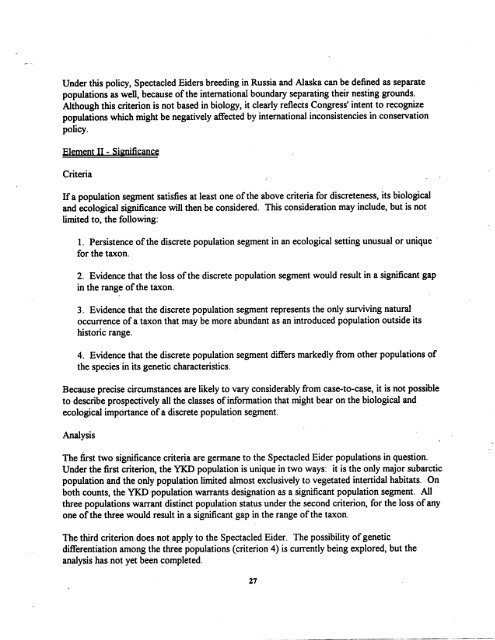A. Status of the Spectacled Eider - U.S. Fish and Wildlife Service
A. Status of the Spectacled Eider - U.S. Fish and Wildlife Service
A. Status of the Spectacled Eider - U.S. Fish and Wildlife Service
Create successful ePaper yourself
Turn your PDF publications into a flip-book with our unique Google optimized e-Paper software.
Under this policy, <strong>Spectacled</strong> <strong>Eider</strong>s breeding in Russia <strong>and</strong> Alaska can be defined as separate<br />
populations as well, because <strong>of</strong><strong>the</strong> international boundary separating <strong>the</strong>ir nesting grounds.<br />
Although this criterion is not based in biology, it clearly reflects Congress’ intent to recognize<br />
populations which might be negatively affected by international inconsistencies in conservation<br />
policy.<br />
Element II- Significance<br />
Criteria<br />
If a population segment satisfies at least one <strong>of</strong><strong>the</strong> above criteria for discreteness, its biological<br />
<strong>and</strong> ecological significance will <strong>the</strong>n be considered. This consideration may include, but is not<br />
limited to, <strong>the</strong> following:<br />
1. Persistence <strong>of</strong><strong>the</strong> discrete population segment in an ecological setting unusual or unique<br />
for <strong>the</strong> taxon.<br />
2. Evidence that <strong>the</strong> loss <strong>of</strong><strong>the</strong> discrete population segment would result in a significant gap<br />
in <strong>the</strong> range <strong>of</strong><strong>the</strong> taxon.<br />
3. Evidence that <strong>the</strong> discrete population segment represents <strong>the</strong> only surviving natural<br />
occurrence <strong>of</strong>a taxon that may be more abundant as an introduced population outside its<br />
historic range.<br />
4. Evidence that <strong>the</strong> discrete population segment differs markedly from o<strong>the</strong>r populations <strong>of</strong><br />
<strong>the</strong> species in its genetic characteristics.<br />
Because precise circumstances are likely to vary considerably from case-to-case, it is not possible<br />
to describe prospectively all <strong>the</strong> classes <strong>of</strong>information that might bear on <strong>the</strong> biological <strong>and</strong><br />
ecological importance <strong>of</strong>a discrete population segment.<br />
Analysis<br />
The first two significance criteria are germane to <strong>the</strong> <strong>Spectacled</strong> <strong>Eider</strong> populations in question.<br />
Under <strong>the</strong> first criterion, <strong>the</strong> YKD population is unique in two ways: it is <strong>the</strong> only major subarctic<br />
population <strong>and</strong> <strong>the</strong> only population limited almost exclusively to vegetated intertidal habitats. On<br />
both counts, <strong>the</strong> YKD population warrants designation as a significant population segment. All<br />
three populations warrant distinct population status under <strong>the</strong> second criterion, for <strong>the</strong> loss <strong>of</strong>any<br />
one <strong>of</strong><strong>the</strong> three would result in a significant gap in <strong>the</strong> range <strong>of</strong><strong>the</strong> taxon.<br />
The third criterion does not apply to <strong>the</strong> <strong>Spectacled</strong> <strong>Eider</strong>. The possibility <strong>of</strong>genetic<br />
differentiation among <strong>the</strong> three populations (criterion 4) is currently being explored, but <strong>the</strong><br />
analysis has not yet been completed.<br />
27

















